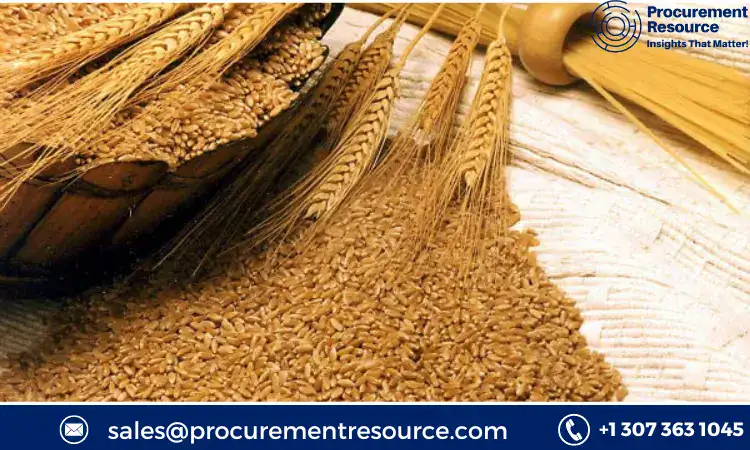
The latest report titled “Milling Wheat Production” by Procurement Resource, a global procurement research and consulting firm, provides an in-depth cost analysis of the production process of Milling Wheat.
Procurement Resource study is based on the latest prices and other economic data available. It also offers additional analysis of the report with detailed breakdown of all cost components (capital investment details, production cost details, economics for another plant location, dynamic cost model). In addition, the report incorporates the production process with detailed process and material flow, capital investment, operating costs along with financial expenses and depreciation charges.
Request For Free Sample: https://procurementresource.com/production-cost-report-store/milling-wheat/request-sample
Procurement Resource’s detailed report describes the stepwise consumption of material and utilities along with a detailed process flow diagram. Furthermore, the study assesses the latest developments within the industry that might influence Milling Wheat production cost, looking into capacity expansions, plant turnarounds, mergers, acquisitions, and investments.
Procurement Resource Assessment of Milling Wheat Production Process:
1. Milling Wheat Production Cost From Cleaning, Conditioning, Gristing, Separating and Milling: This report presents the detailed production methodology and cost analysis of Milling Wheat industrial production across Milling Wheat manufacturing plants. The first step is to clean the grains by removing any impurities, such as stones and sticks, followed by conditioning, where the grains are soaked in water to remove the bran and achieve uniform moisture. The conditioned grains are then mixed with cleaned wheat, which is known as gristing. Further, the mixture is rolled through rollers to extract the outer bran portion of the grain, then powdered and sifted. Finally, the wheat is crushed and sieved again to obtain the milled wheat or wheat flour.
Request For Free Sample: https://procurementresource.com/cost-analysis/milling-wheat-production-via-cleaning-conditioning-gristing-separating-and-milling/requestsample
Product Definition:
Milling wheat involves analyzing, blending, grinding, sifting, and blending various types of wheat. The miller carefully examines the grain and blends it to meet the specific needs of the final product. Various types of wheat are cultivated in different parts of the world, all of which originate from the Triticum grass. The most commonly grown species is referred to as bread wheat or common wheat. Wheat flour is produced by milling, which involves a series of steps such as separating the bran and germ from the endosperm and then grinding the endosperm into fine flour. This multi-step process is crucial in achieving the desired quality of wheat flour.
Market Drivers:
The practice of milling or grinding is a well-known technique in the food industry, which is widely used to reduce the size of various raw materials, flours, and intermediate products. Additionally, this process is commonly employed to extract gluten and starch through the process of wet milling. Among the different crops that are used for milling, wheat stands out as a particularly popular and abundant choice due to its affordability and high nutritional value. Given its overall availability, wheat is frequently used as a staple food in many countries around the world, including India and other regions. For instance, hard wheat is used for making different types of bread, while durum semolina and flour are commonly used in pasta. Asian noodles can be made by blending both soft and hard kinds of wheat, while soft wheat is used to create a variety of food products such as crackers, cookies, cereals, cakes, pancakes, breading, and pastries.
Looking for an exhaustive and personalised report that could significantly substantiate your business?
Although Procurement Resource leaves no page unfurled in terms of the rigorous research for the commodities that make the heftiest base of your business, we incline more towards tailoring the reports per your specificities. All you need is one-to-one consulting with our seasoned consultants to comprehend the prime parameters you are looking to pin your research on.
Some of the common requests we receive from our clients include:
- Adapting the report to the country/region where you intend to establish your plant.
- Adjusting the manufacturing capacity of the plant according to your needs.
- Customizing machinery suppliers and costs to meet your requirements.
- Providing additional information to the existing scope based on your needs.
About Us:
Procurement Resource ensures that our clients remain at the vanguard of their industries by providing actionable procurement intelligence with the help of our expert analysts, researchers, and domain experts. Our team of highly seasoned analysts undertakes extensive research to provide our customers with the latest and up-to-date market reports, cost models, price analysis, benchmarking, and category insights, which aid in simplifying the procurement process for our clientele.
Procurement Resource work with a diverse range of procurement teams across industries to get real-time data and insights that can be effectively implemented by our customers. As a team of experts, we also track the prices and production costs of an extensive range of goods and commodities, thus, providing you with updated and reliable data.
We, at Procurement Resource, with the help of the latest and cutting-edge techniques in the industry, help our clients understand the supply chain, procurement, and industry climate so that they can form strategies that ensure their optimum growth.
Contact Us:
Company Name: Procurement Resource
Contact Person: Jorge Garcia
Email: sales@procurementresource.com
Toll-Free Number: USA & Canada – Phone no: +1 307 363 1045 | UK – Phone no: +44 7537 132103 | Asia-Pacific (APAC) – Phone no: +91 1203185500
Address: 30 North Gould Street, Sheridan, WY 82801, USA






